Devotees “Hungry to Hear” at Festival of Inspiration in New Vrindaban
Devotees “Hungry to Hear” at Festival of Inspiration
By Madhava Smullen
Arriving at Festival of Inspiration — seeing the rows of cars in the parking lot, the book and merchandise booths, the huge prasadam tent, the hundreds of devotees milling about on the lawns in front of New Vrindaban’s ISKCON temple and enjoying each other’s association – is like meeting an old friend. It’s fun, enlivening, and there’s always so much to hear and share.
This year’s 14th annual Festival drew around 550 devotees from all over North America, slightly fewer than usual due to parallel events like Chicago’s Nama Yajna Festival and North Carolina’s Sadhu Sanga Retreat. But according to organizer Vrindavana Das, this only served to create an intimate atmosphere that was relished by all the devotees.
Attendees dived straight into the nectarean experience on the evening of Thursday May 8th, as Hari Sauri Das and Sruta Kirti Das, who both acted as personal servants of Srila Prabhupada, shared their memories in an impromptu gathering.
Friday May 9th and Saturday May 10th were the core festival days, with 18 presenters giving seminars on a wide range of Krishna conscious topics from 10:30am to 6:30pm.
With three seminars going on at once, festivalgoers had a choice of some of the best speakers in ISKCON, including Bhaktivedanta College principal Yadunandana Swami on how to preserve Prabhupada’s legacy, scholar Bhakti Vasudeva Swami on youth empowerment, BBT editor Dravida Das on hearing and chanting, and Anuttama Das on strategic planning for life.
Some of the most popular seminars were those on Srila Prabhupada. Devotees savored Hari Sauri’s “Srila Prabhupada: The Living Bhagavatam” on how the ISKCON founder applied and lived the philosophy of Krishna consciousness, as well as Srutakirti’s sweet personal memories.
Srutakirti explains that he strives to give devotees an experience of Srila Prabhupada when he speaks. “Prabhupada is the essence of everything we’re trying to understand as devotees,” he says. “So I hope to not just glorify him but also show what our goal is (through him).”
He also spoke about how encouraging Prabhupada was. “Everything Prabhupada did was to encourage us,” he says. “And I think it’s important in a society of devotees to understand that the whole purpose of association with others is to give encouragement and to become encouraged.”
Also extremely popular was “Failure is the Pillar of Success,” a seminar by Vaisesika Das, who is known for counseling and inspiring devotees around the world. Packing the main community hall in the Palace Lodge, he spoke about the attitudes, such as pride, laxity and justification, that can lead to stumbles on the spiritual path.
Like Srutakirti’s seminar, Vaisesika’s also focused on encouragement, the essence of “Festival of Inspiration.” He reassured devotees that they should not be discouraged if they fall along the path, but should continue happily practicing devotional service with full faith. Thus, they’ll eventually come to the perfect stage. Quoting Srila Prabhupada in “Light of the Bhagavat,” he said, “Failures may not be detrimental; they may be the pillars of success.”
This had Vaisesika’s audience feeling very encouraged, and their response in turn inspired him. “My impression was that devotees at Festival of Inspiration are very hungry to hear about Krishna,” he says. “They drank everything like nectar. It was very encouraging to see.”
Meanwhile throughout the day children aged 5 to 12 had their own Krishna conscious activities in the Kids’ Tent, allowing their parents to attend seminars. New Vrindaban veteran teacher Lilasuka Dasi, Jaya Sri Vrinda and Laura from Gainesville’s Krishna House, and local teacher Olivia kept the 30 kids who attended busy.
“We started each session with a kirtan, and they all took turns leading,” says Lilasuka. “We learned a Bhagavad-gita verse, and did an activity based on the verse. We made necklaces and friendship bracelets for Mother’s Day. And there was facepainting, and a clown making Krishna conscious balloon figures.”
As well as daytime seminars and activities, devotees also relished the special morning Bhagavatam classes. On Friday, Ramesvara Das spoke about the importance of compassion. On Saturday scholar Radhika Ramana Das gave a class full of personal realization on prayer. And on Sunday — Mother’s Day — Vaisesika Das spoke on the motherly qualities we should develop, and on how Krishna’s affection for his devotees is like that of millions of mothers.
In the evenings, devotees packed into the temple to sing bhajans with Vaisesika Das, Yadunandana Swami, Mayapur kirtaniya Uttama Bhakta Das, and mantra rock legend Titiksava Karunika Das. “That was one of the best parts of the festival for me,” says organizer Vrindavana Das, who found the Holy Name rejuvenating amidst his hard work.
On Sunday, everyone was thrilled by Bhakti Marg Swami’s drama “The Little Big Ramayana,” which condensed the ancient epic’s themes of good and evil, loyalty, love and devotion into one hour. “It was very action packed and fast moving,” says longtime New Vrindaban-resident Jayasri Dasi, who helped organize the festival.
Throughout the festival, devotees fueled up three times a day with a typically delicious Festival of Inspiration menu. Renowned cooks Shankha Das, Madan Mohan Das, and Radha Dasi didn’t even let grain-free Ekadasi stop them, whipping up a sumptuous array of creamy mashed potatoes, aloo tikki, carrot halava, salad, fresh juice and even buckwheat cake. Meanwhile Sunday’s traditional feast with its paneer subji, mango drink and strawberry sweet rice had devotees in a beaming state of bliss.
Organizer Vrindavana Das says all enjoyed the festival immensely and are looking forward to coming back for the grand 15th anniversary of Festival of Inspiration in 2015.
Vrindavana is planning to make the 15th year one to remember, coordinating with other festivals to make sure there are no clashes and inviting a long list of Swamis, legendary kirtaniyas, and Festival of Inspiration staples. He’s also reserving enough accommodation at New Vrindaban and local hotels for 800 guests.
“Festival of Inspiration is such a privilege,” he says. “It’s really a wonderful opportunity for me to serve so many wonderful devotees.”
New Vrindaban’s Transcendental Throwback Thursday – 06/12/14
New Vrindaban’s Transcendental Throwback Thursday – 06/12/14.
Each week we highlight an earlier era of ISKCON New Vrindaban.
This week’s challenge: There at least 5 devotees whose faces are recognizable in this photo. How many can you identify?
Extra credit: Where are they and what’s the occasion?
What to do: Post your guesses on the “who, what, when, where & why” in the comment section at the New Vrindaban Facebook Page.
Technical stuff: We share a photo Thursday and confirm known details Sunday. Let’s keep it light and have a bit of fun!
Special request: If you have a photo showing New Vrindaban devotees in action, share it with us and we’ll use it in a future posting.
New Vrindaban Daily darsan @ June 10, 2014.
Srimati Radharani’s maidservants are very beautiful. The vines of their arms and wrists are charmingly decorated with bracelets and armlets. The bells on their sashes and anklets tinkle melodiously. Their jewelled earrings are lovely. Their glistening braided hair is charming and splendid and the flower buds of their breasts are nicely decorated with necklaces of jewels. They have given all their love to their mistress, Sri Radha. In this way please meditate on the golden-complexioned maidservants of Srimati Radharani.
Source : Nectarean Glories of Sri Vrindavana-dhama by Srila Prabodhananda Sarasvati Thakura, Sataka-2, Text-59, Translation.]
New Vrindaban Daily darsan @ June 8, 2014.
Filled with amorous desires, Sri Sri Radha and Krsna gracefully enter the palace of vines. Their glistening eyes, words, limbs, and motions are all filled with nectar, and Their eyes move with amorous playfulness. Seeing all this, Radha’s maidservants begin to discreetly go outside, but the smiling divine couple brings them back in. They are plunged in shyness and bliss at the same moment. These teenage maidservants of Srimati Radharani have complexions as splendid as gold. They are ravishingly beautiful, with beautiful slender waists and very large breasts and hips, and each wears in her nose a pearl studded with jewels and gold. Their braided hair, their garments, and their ornaments, are all very beautiful. Please meditate on Srimati Radharani’s maidservants in this way.
Source : Nectarean Glories of Sri Vrindavana-dhama by Srila Prabodhananda Sarasvati Thakura, Sataka-2, Text-57-58, Translation.]
Srila Prabhupada Designs A Horse Driven Cart For Use At New Vrindaban – May 1969.
Srila Prabhupada Designs A Horse Driven Cart For Use At New Vrindaban.
Srila Prabhupada’s First Visit to New Vrindaban – May, 1969.
Excerpt from “The Hare Krishna Explosion.”
Chapter 18 titled: “Paramhansa in the Hills.”
By Hayagriva das.
As the late May days pass—beautiful, lengthening days with brief afternoon thundershowers—Prabhupada gradually builds his community, throwing out ideas, planning, even designing a two-wheel cart for the workhorses.
“With this kind of cart,” he says, showing me a drawing, “you can more readily go up and down the road. It will be easy for the horses to pull.”
Read the rest of the chapter HERE.
Long-time New Vrindaban Resident achieves Finalist for an Indie Book Award
Sankirtana Das is a disciple of Srila Prabhupada and a 38 year resident of New Vrindaban. He is a sacred storyteller, workshop leader and author of Mahabharata: The Eternal Quest. He was interviewed by Lilasuka Devi Dasi, Communications Director at New Vrindaban on May 11, 2014
Q. Congratulations. So how does it feel that your book was just selected as Finalist for the 2014 Next Generation Indie Book Awards?
A. Well, I have a good, warm feeling about it. On the other hand, I also feel that I didn’t write the book, that somehow, Krishna just let it all fall into place. I’m amazed that all the major elements and personalities of Mahabharata are all there in just 280 pages.
Q. That’s certainly a major feat. Mahabharata is 100,000 slokas. How did you manage to fit it into 280 pages?
A. It took ten years of strategizing on how to piece it all together to make it work. The writing was at times both a joyous and a nerve wracking experience. It’s like a huge puzzle, and every piece had to fit into place. Sometimes I had serious doubts about pulling it off and if it would actually work. I wanted the book to be for college courses, so the text couldn’t be too long. The book is fast-paced. The art of storytelling is to focus on the action and the characters with only minimal description. The idea is to just give enough description to activate the imagination of the reader or listener that they themselves can fill in the scenes. Now that it’s out, the response from scholars and readers has been tremendous.
Q. How did you go about writing the book?
A. I knew bits and pieces of Mahabharata from Prabhupada’s first and tenth canto of Srimad Bhagavatam and from performing scenes from it over the years. But I didn’t know the details of how the whole story unfolded. I wrote the book, primarily, to get a better understanding of it for myself. So I looked at those chapters from Bhagavatam and also referred to the first complete English translation of Mahabharata written by Mohan Ganguli in 1896.
Q. There have been a number of Mahabharatas in the last few decades. What is the need for another Mahabharata?
A. Several devotees have asked me that. When Lokamangala prabhu and I toured with our two-man drama of Mahabharata, people would sometimes say we should do a movie. That never happened. So my other intention with this book was: what would the Mahabharata look like if I had the chance to make it into a movie. In my rendition of Mahabharata I bring to bear my background in theater, cinema and literature. I wanted to get to the essence of the Mahabharata and offer a very dramatic and cinematic reading experience. A book that is character driven.
Q. I think you’ve accomplished that. Who was your target audience?
A. Mahabharata: The Eternal Quest is meant to help devotees introduce Mahabharata to the public in general, and especially to their college audiences and contacts. I structured Mahabharata to be used in college courses that could easily be studied and enjoyed. Right now many courses are using William Buck’s version.
Q. And what’s the difference between the two?
A. There are many discrepancies in his book. For instance, Yudhuisthira’s Rajasuya sacrifice is totally omitted. It’s a major scene, and so there’s really no motivation for Duryodhan to sink into his profound depression and envy. Buck often departs from the meaning and intention of the original text.
Q. So, what’s the message of your book? You spoke about getting “to the essence.” What do you consider the essence?
A. The essence is Krishna’s intimate relationship with the Pandavas. Also, I wanted to give people a proper understanding of dharma, and to show succinctly that this ancient text is still relevant today. In making Krishna Consciousness available to the public, devotees need to demonstrate its relevancy to today’s issues and concerns. And Srila Prabhupada explains that our philosophy is very relevant on many levels. Mahabharata does all this while telling a fantastic story. It’s for story lovers. So I think my book can be a vital tool.
Q. What advice do you have for writers?
A. Be very organized. It will save you a lot of headaches. I’m speaking from personal experience.
B. When did you begin to think of yourself as a writer?
A. When I was a kid – twelve or thirteen – I was struck by the impact books and movies made on me. I wanted to give that experience to others.
Q. And finally, what projects are you working on?
A. One thing – just promoting Mahabharata takes up a lot of time. And although I have two uncompleted book projects, I want to work on a third which I feel is more important. Also, I plan to do several storytelling CD’s. I’m just about ready with – Brahma’s Song. It’s subtitle is: A Concert of Storytelling, Music and Chants.
Q. And if readers want more info about the book they can go to www.Mahabharata-Project.com Thanks for a great interview.
A. And thank you.
New Vrindaban Congregational Department Fans the Spiritual Spark
By Madhava Smullen
Bhakta Josef Lauber clearly loves his service. It comes through in his voice, as the words tumble out in a colorful torrent, filled with emotion.
And why wouldn’t he? As head of ISKCON New Vrindaban’s Congregational Development Department, he is constantly guiding newcomers in Krishna consciousness, watching them learn, seeing their enthusiasm and their love for God build.
Josef reaches out to the 25,000 Westerners and Indian immigrants who visit New Vrindaban every year, giving many of them instructions on how to chant Hare Krishna, and sending them home with japa beads and Srila Prabhupada’s books.
“I love sitting down with visitors who drove six to ten hours from Washington, New York, Chicago, Toronto, and beyond, reading and reciting the Bhagavad-gita with them and seeing them soak it all up,” he says. “And then seeing how they start reading and chanting, taking Bhagavad-gita and Bhakti Sastri courses by phone conference call, and even how some of them eventually get initiated.”
Josef has also revived the Govardhana parikrama that Varshana Swami created to scale according to Srila Prabhupada’s instructions. And every Sunday morning, he takes guests on a two-hour tour of replicas of the sacred hill and the lakes Kusum Sarovara, Manasi Ganga, Lalita Kunda, and Radha Kunda, while narrating Krishna’s pastimes.
“After two hours of singing the Holy Name, hearing Krishna Katha, breathing the fresh air, and seeing the untouched beauty of nature in New Vrindaban, you can see how they revive their spiritual selves, and become happy,” he says.
Another of Josef’s favorite activities is his outreach program, in which he and other members of the Congregational Development Department visit friends of New Vrindaban, invite them for a return visit, give them books and encourage them in their Krishna consciousness.
“Sometimes we’ll do a house-warming ceremony, or try to accommodate whatever else is happening in their lives,” he says. “Going to their homes, and seeing their devotion — how they center their lives around their home Deities and chant on their beads every morning, despite the struggles of everyday life — really touches my heart.”
Another element of Josef’s service is raising the large amount of funds needed to keep New Vrindaban running every year. With three years of experience as a fundraiser for Greenpeace, and ten running his own fundraising consulting company for non-profit organizations, he’s an expert, inspiring many to donate towards the community’s cow protection and other needs.
While it’s predominantly Indian congregation members who donate and participate in the above programs due to their natural attraction to Krishna consciousness, Josef is also involved in a number of efforts specifically targeted at reaching out to a Western audience.
Chief of these is his service as promoter for Srila Prabhupada’s Palace, known as The Palace of Gold to tourists. Rated one of “8 Religious Wonders to See in The US” by CNN Travel as recently as 2012, the Palace is still New Vrindaban’s ace, and Josef knows it.
Through local TV and newspaper ads, flyers in nearby hotels, and collaborations with local tourist agencies, he has already significantly increased the number of non-Indian visitors since last year. And he attracted major interest from Lenzner, one of the biggest bus tour operators in the US, when 25 of the company’s managers visited New Vrindaban in late April.
“The Palace of Gold is an asset that has potential to revive New Vrindaban as a place of pilgrimage, just like Srila Prabhupada wanted,” he says.
Josef is also a firm believer in the Festival of Colors, introduced in 2012, as a major way to attract Westerners to Krishna consciousness. Last year, over three-and-a-half thousand people, mostly young students from nearby universities, attended the event at New Vrindaban, with nearly twice as many expected this year.
And the first Pittsburgh Festival of Colors, put on by New Vrindaban devotees on April 19th this year, drew between five and six thousand students from three universities.
To achieve success in all these projects, it’s essential for the New Vrindaban Congregational Development Department to work as a team, one of the most important things that Josef has brought to it.
“I’m trying to cultivate a Vaishnava-like atmosphere of helping each other and an enlivening team spirit where everybody feels welcome and accommodated,” he says.
Josef has many more improvements he hopes to implement in the future. He hopes to grow his team from three active preachers to six or seven, further refine his database of contacts, build a solid base of monthly donations, and upgrade Radha-Vrindabanchandra’s swan boat.
With New Vrindaban’s Palace Lodge already beautifully refurbished, he hopes to repeat the process with the cabins by the lake for more quality accommodation, and to renovate the Palace of Gold, a ten-year, multi-million-dollar project.
Meanwhile on the spiritual side, he hopes in the future to see a more systematized way of preaching in the form of an academy where the congregation can study the scriptures and receive Bhakti Sastri diplomas.
New Vrindaban’s Transcendental Throwback Thursday – 06/05/14
New Vrindaban’s Transcendental Throwback Thursday – 06/05/14.
Each week we highlight an earlier era of ISKCON New Vrindaban.
This week’s challenge: In this photo with Srila Prabhupada there at least 10 devotees whose face can be seen, including a number of ladies. Who can you identify?
Extra credit: Where are they and who currently lives in that location?
What to do: Post your guesses on the “who, what, when, where & why” in the comment section at the New Vrindaban Facebook Page.
Technical stuff: We share a photo Thursday and confirm known details Sunday. Let’s keep it light and have a bit of fun!
Special request: If you have a photo showing New Vrindaban devotees in action, share it with us and we’ll use it in a future posting.
New Vrindaban Daily darsan @ June 4, 2014.
Crying in a voice filled with pain, rolling about on the ground, bowing down to offer respect to the person who is his dearmost friend, placing blades of grass between his teeth, and with millions of plaintive words begging for the merciful glance of his two masters, staying all alone at the base of a tree in Vrndavana forest, resting his cheek on his left hand, and shedding many tears, a certain incomparably fortunate person spends his day and nights.
Source : Nectarean Glories of Sri Vrindavana-dhama by Srila Prabodhananda Sarasvati Thakura, Sataka-2, Text-54, Translation.]
Please click here for more photos ….
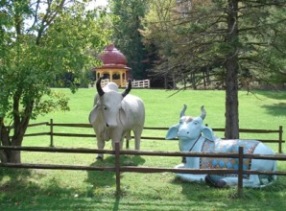
Welcome to Brijabasi Spirit
Thank you for taking the time to visit the New Vrindaban community blog. Think of visiting our blog as making a virtual pilgrimage.
Hare Krishna Hare KrishnaKrishna Krishna Hare Hare
Hare Rama Hare Rama
Rama Rama Hare Hare
"May cows stay in front of me; may cows stay behind me; may cows stay on both sides of me. May I always reside in the midst of cows."
Hari Bhakti-vilas 16.252
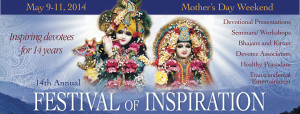


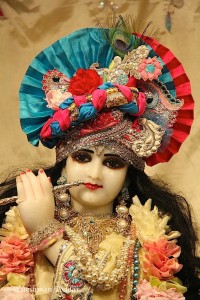

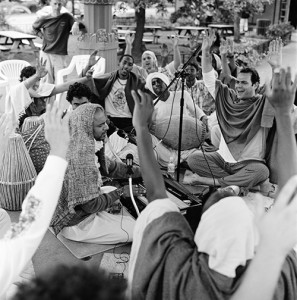
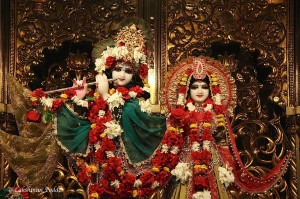



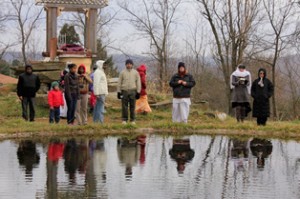










Recent Comments